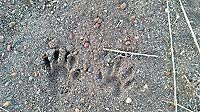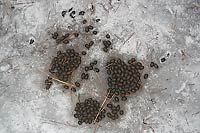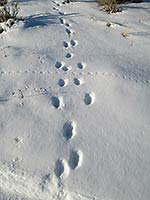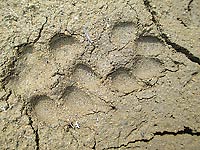 Winter season is a great time to hone your nature detective sleuthing skills. Muddy or snow-covered trails, sandy washes dusted with frost, even urban areas where animals tread, these are all great locations to search for signs of wildife. Of course, wildlife signs can also help.
Winter season is a great time to hone your nature detective sleuthing skills. Muddy or snow-covered trails, sandy washes dusted with frost, even urban areas where animals tread, these are all great locations to search for signs of wildife. Of course, wildlife signs can also help.
Although cold-blooded reptiles and amphibians are mostly absent from the winter landscape, the occasional warm spell allows for small side-blotched lizards to make a brief appearance. Their small bodies take less energy to warm up than the larger lizards or snakes, and their tracks and tail drags might show on sandy patches. Reptile  “hibernation” is called “brumation,” their metabolic processes differ than mammals that hibernate. This state of suspended animation can change as the weather warms, but the lizards or snakes that do emerge might only take in water and not seek prey.
“hibernation” is called “brumation,” their metabolic processes differ than mammals that hibernate. This state of suspended animation can change as the weather warms, but the lizards or snakes that do emerge might only take in water and not seek prey.
Two other good reasons to search for wildlife sign in the middle of winter is that there tends to be less human disturbance and some species herd up to search for food or avoid predators. This herding instinct increases the chances of finding tracks or scats, and the fewer people out means less disturbance and disruption of the tracking landscape.
D ue to the nocturnal schedule or stealthy nature of desert wildlife, encounters may be rare or fleeting. Just as birdwatchers can identify birds by their songs, so too might the nature detective identify species of wildlife through the signs of their passing. Or maybe what they passed.
ue to the nocturnal schedule or stealthy nature of desert wildlife, encounters may be rare or fleeting. Just as birdwatchers can identify birds by their songs, so too might the nature detective identify species of wildlife through the signs of their passing. Or maybe what they passed.
For instance, take raccoons. Active at night, we might see their eye shine in our car headlights or hear the clatter and crash of cans as they search for food. Though rarely seen, their unique track side-by-side front and rear foot patterns indicate their presence. I’ve seen tracks across a frosty deck or in the soft ground, but their passage was undetected by even our sleeping dog. These creatures might also leave their calling card, a small pile of scat that contains seeds or berries.
Although on the edge of town, the Moab Sloughs or Matheson Preserve is a good place to look for wildlife. This refuge on the edge of town provides cover and food for a variety of winter species, and sometimes the boardwalk, fresh with dew or frost, is a good substrate to observe tracks of small mammals, deer, coyotes or an elusive gray fox out hunting small rodents.
 But going farther afield, out into Arches National Park or the Courthouse Uplands or the Cisco Desert offers opportunities to find mule deer, pronghorn, foxes, coyotes and maybe even a cougar. Of course, smaller prey like cottontails, jackrabbits and small rodents are out and about in these areas. The 7-pattern of the hare tracks is unmistakable, but sorting out the mice tracks is harder. There are numerous species out here, and the small 4-square track pattern betrays their presence.
But going farther afield, out into Arches National Park or the Courthouse Uplands or the Cisco Desert offers opportunities to find mule deer, pronghorn, foxes, coyotes and maybe even a cougar. Of course, smaller prey like cottontails, jackrabbits and small rodents are out and about in these areas. The 7-pattern of the hare tracks is unmistakable, but sorting out the mice tracks is harder. There are numerous species out here, and the small 4-square track pattern betrays their presence.
Of course, if there is any scat on the ground, that is always worth a stop and second look. The poet Alison Hawthorne Deming described a naturalist as a person who was attracted to animal scat, not repelled by it. Shape, size and/or contents can lead to a determination of the originator – or not. Reading the signs, tracks and even the scat provides the sleuth will some clues about the wildlife that roams this landscape.